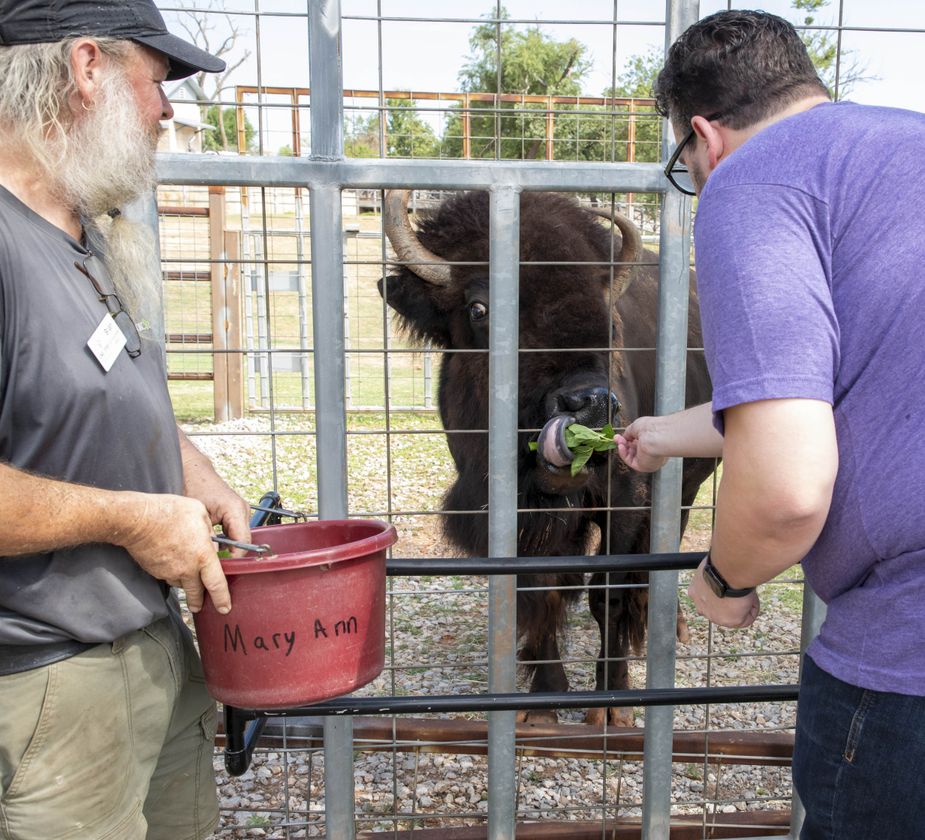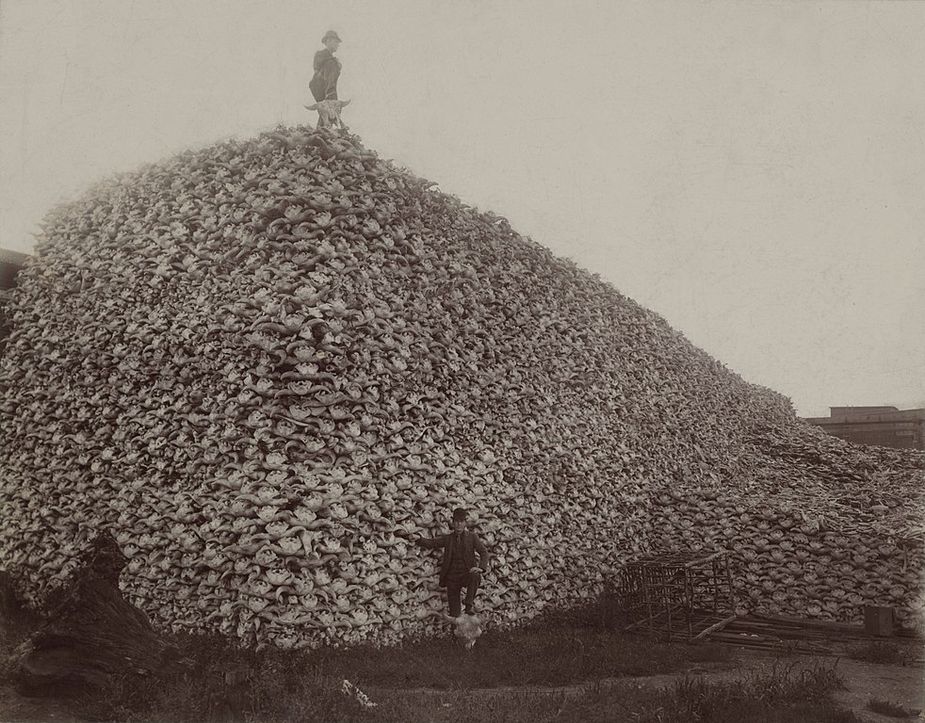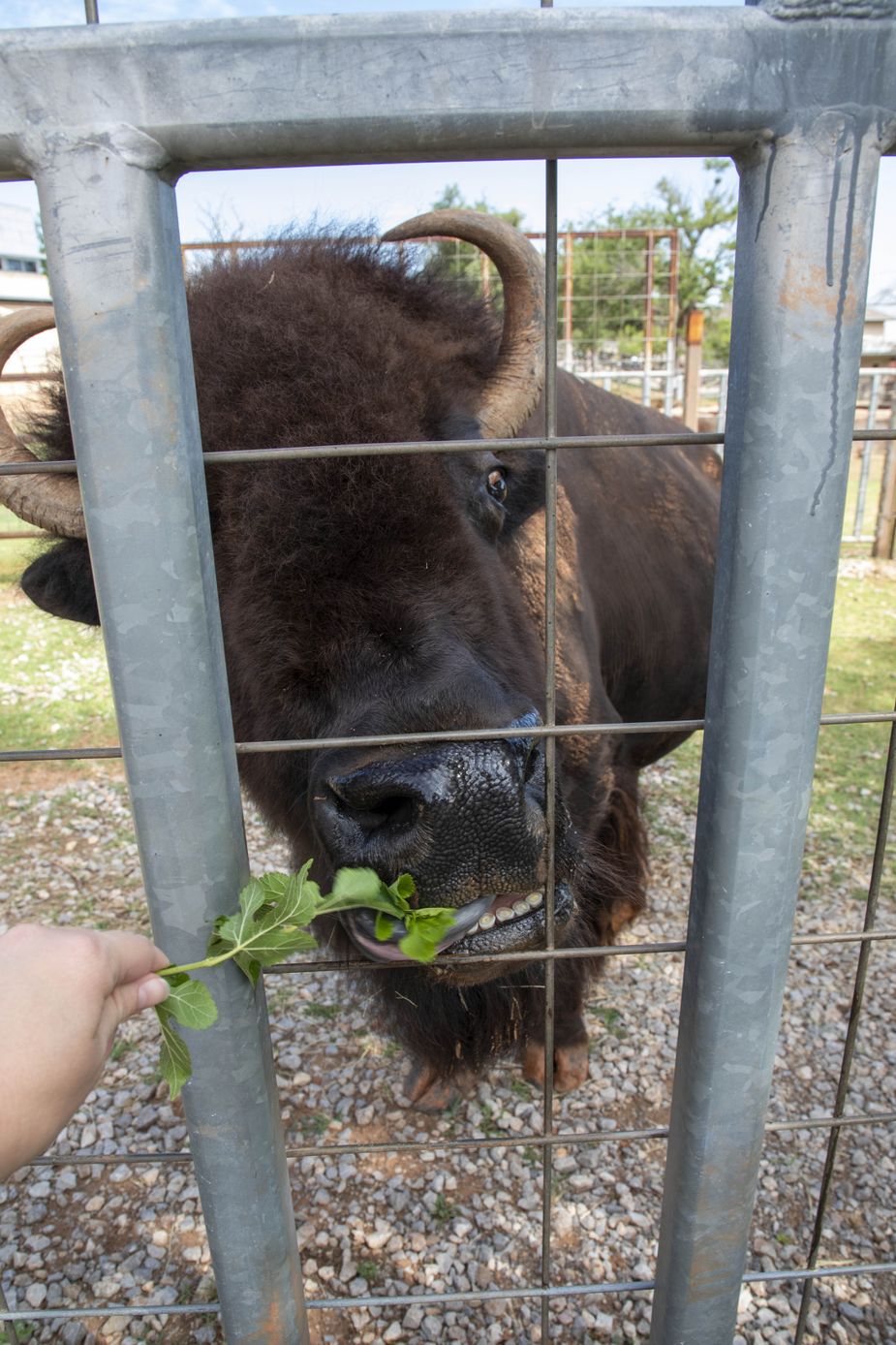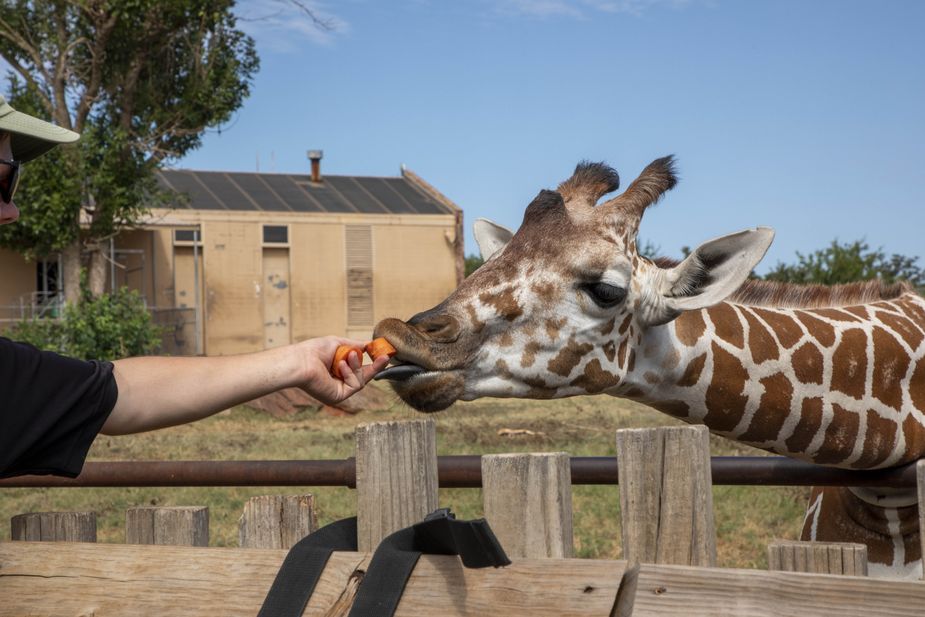Wild Things
Published August 2022
By Greg Elwell | 7 min read

Greg Elwell feeds Mary Ann the bison some greens during a "Wild Encounter" at the Oklahoma City Zoo. Photo by Lori Duckworth
One of the great joys of working at Oklahoma Today is the ability to dive, brain-first, into a variety of new topics. While I’m always happy to eat food and write about it—though I prefer the former to the latter—it’s exciting when I get to stretch my legs and take on something different.
For our upcoming Animal Issue, I got to metaphorically tackle our state mammal, the bison. You should not literally tackle bison for a number of reasons that we’ll get into in a minute.
Bison are everywhere in Oklahoma, if you count sculptures, murals, T-shirts, and other trinkets. But seeing them live and in person isn’t quite so easy. I had known going into the story that vast numbers of bison were exterminated, but I didn’t realize the extent until I began reading old newspaper stories and books about a number of former bison hunters who ended up saving the species.

In this historic photo, a pile of bison skulls await processing for fertilizer or charcoal in Detroit. Photograph courtesy of Burton Historical Collection, Detroit Public Library.
The history of bison in America is pretty grim stuff. Archival photos show mountains of the animals’ skulls waiting to be processed into fertilizer and old advertisements for “hunting by rail” show how casually the slaughter took place. It’s easy to get bummed out when you realize what we had and what we destroyed.
So I was grateful to the Oklahoma City Zoo for a bit of a palate cleanser. I was invited to try one of the new Wild Encounters—a behind-the-scenes chance to interact with some of the zoo’s inhabitants.
Oklahoma City Zoo is home to three bison; a rambunctious pair of two-year olds named Yarrow and Verbena, and the 19-year-old Mary Ann, who was photographed for the National Geographic Photo Ark by Joel Sartore.
Oklahoma Today’s award-winning and even-more-award-deserving photographer extraordinaire Lori Duckworth and I were led back behind a key-access gate to meet with Senior Animal Caretaker Brian Whitsitt, one of the zookeepers who works with the bison. There he introduced us to Mary Ann who, he explained, was in a bit of a snit that morning.

19-year-old Mary Ann munches on some greens at the Oklahoma City Zoo's "Wild Encounter." Photo by Lori Duckworth
Bison are big. Males can weigh around 2,000 lbs. and females, like Mary Ann, clock in near 1,000 lbs. They are also pretty wary of humans—given our history with the species, can you blame them?—and don’t like to be touched,.so our encounter happened through a heavy-duty fence.
Lucky for us, there were a few pieces of recently shed bison fur for us to touch. One way the massive animals keep cool is by dropping rug-sized pieces of their coats as the summer heat sets in. The coat from their backs is softer and fluffier, though still a bit scratchy. The fur from their heads is more wiry and coarse.
Brian taught us how to feed her some greens, presented perpendicularly so she can grasp it with her tongue, and warned not to get your hand too far through the grate. It’s not that she’s a biter; bison’s size makes accidents too easy, and anything stuck through the fence could get hurt if they move the wrong way.
Mary Ann helpfully reminded me of this by banging her horns against the metal when I encroached too far into her space. Thank you, Mary Ann. I’ll do better next time, I promise.
And there will be a next time. Wild Encounters are too much fun for experience junkies to ignore. In addition to the bison encounter, guests can book time with bears, Indian rhinos, Galapagos tortoises, sea lions, and Asian elephants. Tickets start at $36 for members and $40 for nonmembers, but some encounters are more expensive.

Visitors have the opportunity to take part in giraffe feedings every day at the Oklahoma City Zoo. Photo by Lori Duckworth
While we were there, we got to celebrate one of the giraffe’s birthdays and feed some carrots and leafy greens to most of the tower. If you’re looking for a more affordable encounter, giraffe feedings happen daily from 11 a.m. to noon and from 2-2:30 p.m. on weekends, and are better for younger visitors at a cost of just $5.
Though we didn’t stop there this go-round, I also recommend heading to the lorikeet habitat. A small cup of nectar is $4, but it will last a long time with these tiny, colorful, people-friendly birds. Kids might be freaked out when one perches on their shoulder, but the experience soon gives way to joy when you get to see them dip their tiny beaks in for a sip.
"Tuesday Trivia: August 16, 2022"
"Weekly Events Calendar, August 22-28, 2022"
You May Like
Weekly Events Calendar: April 14-20, 2025
This week in Oklahoma: The next-best Beatles experience in Duncan; an Easter extravaganza in Foss; and an activity that truly rocks in Tu...
This week in Oklahoma: The next-best Beatles experience in Duncan; an Easter extravaganza in Foss; and an activity that truly rocks in Tulsa.
Oklahoma Today Podcast: April 14, 2025
30 years after the 1995 bombing of the Alfred P. Murrah federal building in downtown Oklahoma City, OKC Fire Chief Richard Kelley joins t...
30 years after the 1995 bombing of the Alfred P. Murrah federal building in downtown Oklahoma City, OKC Fire Chief Richard Kelley joins the show to talk about his experience as a first responder th...
Some Tips for Introducing First-Time Visitors to OKC
Oklahoma City residents know there is a lot about the city to show off to visitors. But where to begin? Here are a few ideas for getting ...
Oklahoma City residents know there is a lot about the city to show off to visitors. But where to begin? Here are a few ideas for getting your friends to fall in love with OKC.










